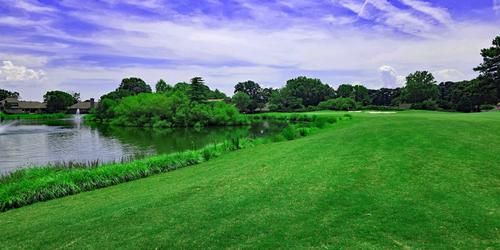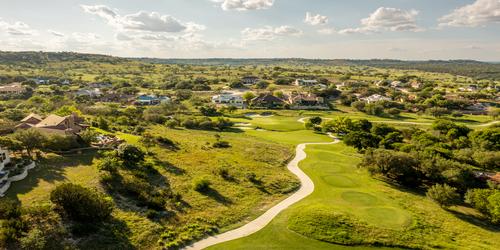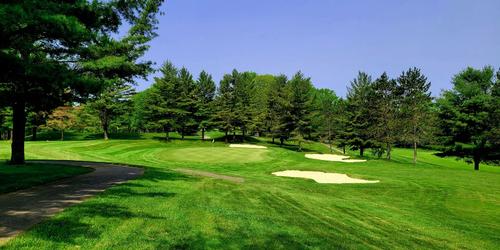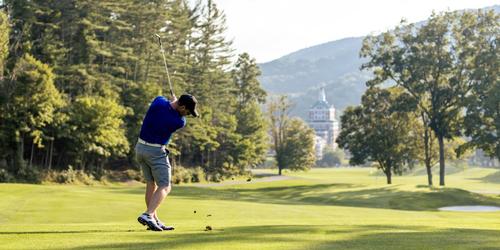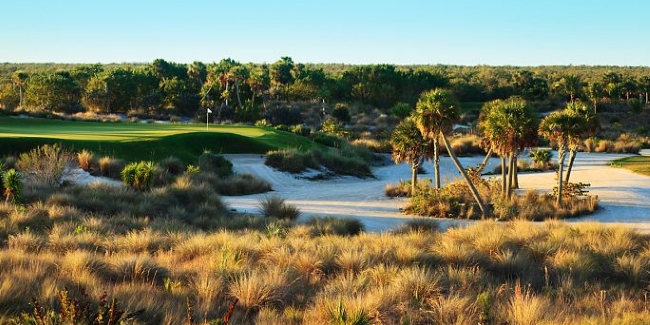
Hammock Bay
One of Naples' Finest and a Welcome Addition to Marriott's Collection
By David Theoret
Hammock Bay Golf & Country Club is set amidst the surrounding beauty of McIvane Bay and the Ten Thousand Islands, on a tract of land that was known for years as Marco Shores Golf Club. It's a Peter Jacobsen/Jim Hardy design that provides an enjoyable challenge to golfers of all levels and abilities. In 2004, Hammock Bay Golf & Country Club was named one of the top 10 new private courses in the world to open by Travel & Leisure Golf Magazine.
It's an 18-hole, par 72 course that plays 6912 yards from the back tees with a course rating of 73.4 and a slope of 134. It will give you all you can handle.
The course tends to highlight the endless beauty of its surroundings; you will find the greens and fairways as lush in the high season as you do in the dog days of summer. Considering this is Florida, the terrain has to be considered unique. For the most part there is a lot of mounding, even some subtle changes in elevation. As far as vegetation and wildlife, Hammock Bay is your typical Florida course with plenty of palms, mangroves, alligators and waterfowl.
The greens are Seaside Dwarf Paspalum (as are the fairways and tee boxes for that matter). This type of grass, although more expensive on the front end requires up to 50% less water, making it more cost effective in the long run. Not to mention a much improved playing and putting surface than its distant relative - Bermuda. The shapes of the greens were designed with the approach in mind. It may take several rounds to figure out where you need to hit the green in order to get it close.
Hammock Bay has a full service clubhouse that includes a pro shop stocked with the latest equipment and fashions, locker rooms with showers, restaurant/lounge, outdoor tiki bar, and meeting facilities.
Memorable Holes:
Number 1: Par 4, 408 yards. The opening hole is a straightforward par four, with the biggest test being distance. Out of bounds and villas on the right as well as large clumps of sea grasses, a waste bunker and deep lipped bunkers on left also place a premium on accuracy. Play the drive close to the bunker, guarding the left side of the fairway, to gain the best angle into the green. However, should you play your drive too far right, you must navigate a deep bunker that protects the right side of the green as well as another one back left. The green slopes slightly from back to front.
Number 4: Par 4, 422 yards. This is the first driving hole without any bunkers to worry about off the tee; favor the right half of the fairway to avoid the bunkers guarding the left side of the green. If you decide to let it rip, be careful; an errant drive could lead to bigger problems with your approach shot to a well-guarded green. The grassy swale short and right is mown tight to add a little more difficulty to the chip shot. It is the number 1 handicap hole on the course.
Number7: Par 3, 157 yards. Number 7 is a medium length par 3 and is the first green without any bunkers around it. If the pin happens to be on the right side of this long, narrow green, the hole plays over water. Those who do not feel up to the test may bale out on the right, although this is not the best option. The green slopes towards the water and wetlands on the left, so a difficult chip awaits those who don't attack the green. Number 7 is no pushover.
Number 8: Par 5, 491 yards. Take your drive over the bunker on the left for the best opportunity to reach this green in two and a shot at eagle. A drive favoring the right must play short of the two bunkers in the fairway. Water is in play on the right and a small pot bunker protects the front left of the green.
Number 9: Par 4, 350 yards. This short hole is sure to be a test of accuracy off of the tee with bunkers short left and long right in the landing area. Your best bet is to take your drive down the left side, and avoid the bunker to set up the best angle into the heavily bunkered green.
Number 10: Par 4, 364 yards. Placement of your tee shot is the key to success on this medium-length par four. With no bunkers to worry about off of the tee, favor the left side of the fairway to avoid the water on your approach shot. The fairway slopes left to right so what you think is a good drive may very well end up in the water. The green is large and slopes left to right in the front and flattens out in the back. Although not the longest, this is a challenging hole.
Number 12: Par 5, 479 yards. Your tee shot is the key to this short par five. Play it down the left side, close to the bunkers of this hard dogleg right, and you could very well get an added kick from the "speed slot". From there you'll have a great chance at reaching the green in two for a chance at eagle. Tee shots played down the right side may be blocked from a go at the green. Those who must lay up will have a dicey short iron into a green protected short right with a large, deep bunker.
Number 13: Par 4, 330 yards. There are two choices off of the tee on this uphill par 4. Be a hero and play your shot down the right side over the large "beach style" bunker and be rewarded with a great chance at birdie. Choose the more conservative route down the left side and you could very well be faced with an obstructed view into a shallow green. This short par four can be as easy or as hard as the player chooses to make it.
Number 14: Par 4, 374 yards. A beautiful, medium length, par four that sweeps left to right around the lake. This is a definite risk/reward hole. If you're still feeling like a hero after the last hole, you have the opportunity to challenge the water and create a short iron approach into the green guarded by a large bunker on the right. The last hole wasn't that kind, you say? Then the safer shot is to take your drive down the left side, and with any luck, around the corner. From there you will be faced with a longer iron shot into the green.
Number 18: Par 4, 411 yards. The closing hole will test your endurance and strength at the end of the round. The tee shot should favor the right side of the fairway; as close to the edge of the lake as possible. From there you will face a long-iron approach shot. Be sure to avoid the lake on the right and the bunker guarding the left side of the large green. Don't be afraid to lay up and try to get up and down for par. This is a very difficult finishing hole, especially into the wind.
Last Word: Now that Hammock Bay is part of Marriott Golf, it is a lot more accessible and is a definite must play if you are visiting the Marco Island area. Water comes into play in some shape or form on 14 holes, and the course is well bunkered both in landing areas off the tee and around the greens. The Seaside Dwarf Paspalum turf runs from tee to green; from my standpoint there is no better grass in Florida.
The par threes are simply nice to look at and at the least quite challenging. Crushed stone waste areas can prove tough to hit from but sure do look good. There is quite a bit of undulation in the fairways for such a flat piece of land; some fairways are lined with trees although for the most part yield ample landing zones. The areas in and around the green are also rolling making pitch shots more challenging and putting even more so.
The practice area at Hammock Bay features a full length driving range where you can hit all of your clubs. There is also a good sized short game area with sand bunker plus a large putting green.
The staff at Hammock Bay is always quite friendly and on top of their game. For more information or to book a tee time, you can visit them online at www.marcoislandmarriott.com or call Head Golf Professional Anthony Schmid at (239) 389-6615.
Revised: 05/05/2014 - Article Viewed 30,728 Times
- View Course Profile
About: David Theoret
![]() David Theoret has been in the golf and golf travel industry for over 10 years, primarily selling online advertising. For the past seven years, he has also been a golf writer, reviewing golf courses, resorts, destinations, equipment, golf apparel, and training aids - the latter of which never seems to help. David's articles and reviews have been posted on many golf travel and equipment websites.
David Theoret has been in the golf and golf travel industry for over 10 years, primarily selling online advertising. For the past seven years, he has also been a golf writer, reviewing golf courses, resorts, destinations, equipment, golf apparel, and training aids - the latter of which never seems to help. David's articles and reviews have been posted on many golf travel and equipment websites.
Growing up in Southwestern Ontario, Canada, it was naturally assumed he would play hockey. Beginning at the age of 3 and continuing into his late 30's, he did just that. However, after one too many pucks to the head, he realized that golf was a lot easier on the body (whoever said hockey players were slow) and took the game up.
After moving to Florida and accepting a position with TravelGolf Media (now part of GolfNow) his love for the game grew exponentially. Most Saturdays you will find him on a course somewhere in Florida or on the practice range reinforcing his bad habits. David plays to a 10 handicap - unless there is money involved in which case it goes considerably higher. He currently resides in Lakeland, FL with his wife Belinda and their two "kids", Madyson and Molly.
Contact David Theoret:
GolfTrips.com - Contributor





